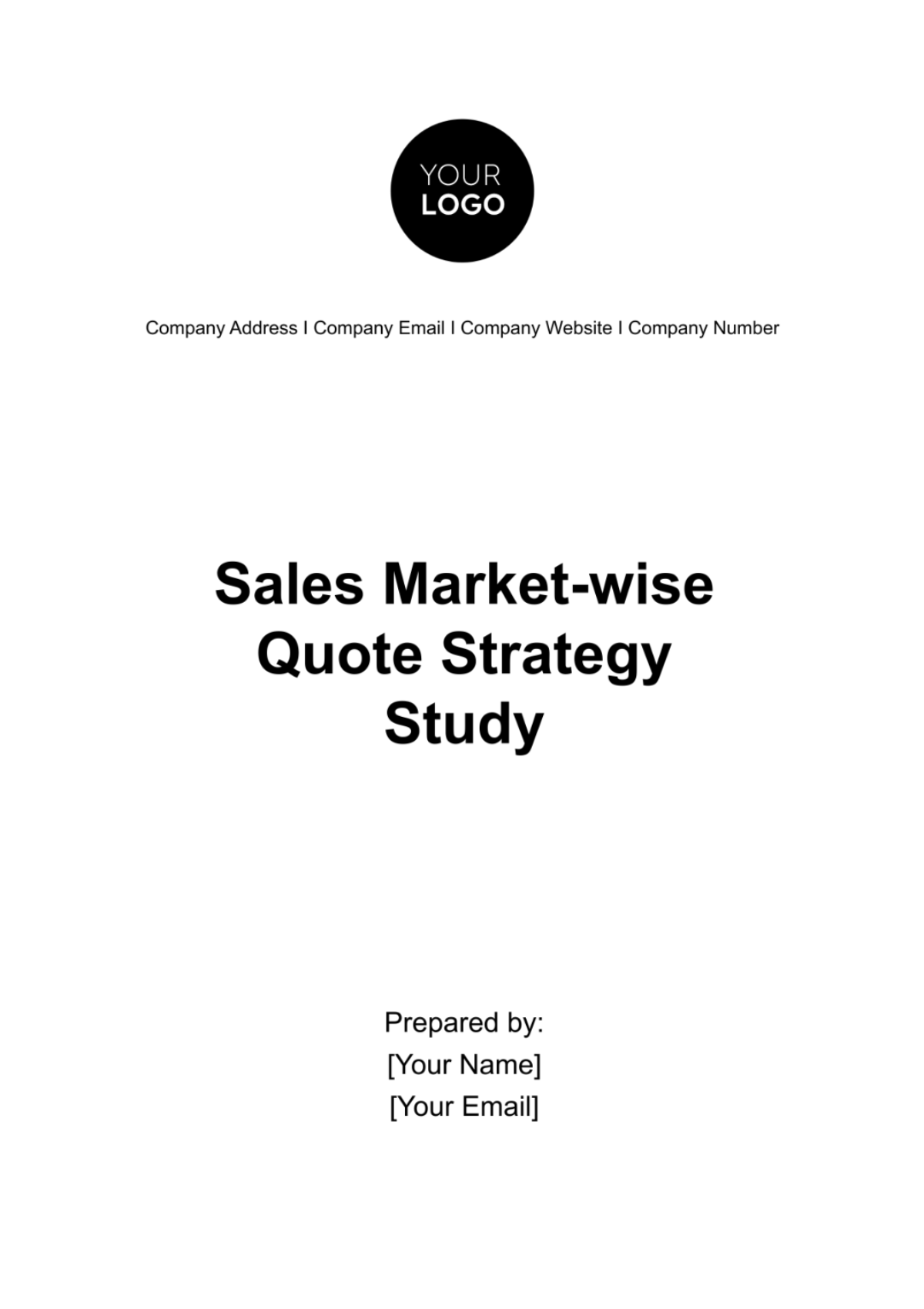Free Sales Market-wise Quote Strategy Study

1. Executive Summary
In today's highly competitive market, a comprehensive Sales Market-wise Quote Strategy Study is essential to guide our company's sales endeavors. This study presents a detailed analysis of our target markets, competitors, pricing strategies, and sales channels. The insights gained from this study will have a profound impact on shaping our sales strategy for the future.
2. Introduction
2.1 Background
The rapidly evolving market landscape, characterized by shifting customer preferences and emerging technologies, necessitates a thorough understanding of market dynamics. This Sales Market-wise Quote Strategy Study aims to provide insights into these changes and their implications for our sales approach. Key market conditions and trends, including the increasing demand for sustainable products and the growing influence of e-commerce, have prompted the need for this study.
2.2 Objectives
The primary objectives of this study are:
To gain a deep understanding of market dynamics, including customer behavior and preferences.
To identify and assess our key competitors, analyzing their strengths and weaknesses.
To devise effective pricing strategies that ensure profitability while remaining competitive.
To explore and optimize our sales channels, adapting to the evolving sales landscape.
By addressing these objectives, we aim to enhance our market position, customer satisfaction, and overall sales performance.
3. Methodology
3.1 Research Methods
To conduct this Sales Market-wise Quote Strategy Study, we employed a comprehensive and multi-faceted research approach. Our methodology was designed to provide a holistic view of the market and its dynamics. Key components of our methodology include:
Data Sources
We gathered data from a diverse range of sources, including industry reports, market research databases, customer surveys, and internal sales data. This approach ensured that our analysis was based on both secondary and primary data, enhancing its accuracy and reliability.
Data Collection Techniques
We conducted structured interviews with key industry experts and stakeholders to gain qualitative insights. Additionally, quantitative data collection methods, such as online surveys and data mining, were used to gather large-scale data sets. This combination of qualitative and quantitative approaches allowed us to triangulate our findings for a more robust analysis.
Analytical Tools and Models
Statistical analysis, including regression analysis and trend forecasting, was employed to process and interpret the collected data. We also utilized advanced analytical tools, such as machine learning algorithms, to assess market trends and competitor positioning, providing a data-driven foundation for our recommendations.
4. Market Analysis
4.1 Market Overview
Our analysis of the target market reveals a dynamic landscape characterized by rapid growth and evolving consumer preferences. Key highlights of the market overview include:
Market Size: As of [2050], the market size stands at [$5.6] billion, with a consistent annual growth rate of [8.5]% over the past five years. This growth is primarily driven by increased demand for sustainable products and technological advancements, making it an attractive market for expansion.
Market Segmentation: The market is segmented into three categories: residential, commercial, and industrial, with residential comprising 45% of the market share, followed by commercial at 35% and industrial at 20%. Understanding these segments is crucial for tailoring our sales strategies effectively.
4.2 Competitor Analysis
Our competitor analysis provides a comprehensive understanding of the competitive landscape. Key findings include:
Key Competitors: We have identified [Acme Solutions], [GlobalTech Innovations], and [Nexa Enterprises] as the primary competitors in our market. Each competitor holds a distinct market position.
Strengths: [Acme Solutions] excels in product innovation and has a strong reputation for quality. [GlobalTech] Innovations boasts a robust global distribution network, while [Nexa Enterprises] is known for exceptional customer service.
Weaknesses: [Acme Solutions] faces challenges in cost competitiveness, [GlobalTech Innovations] struggles with after-sales support, and [Nexa Enterprises] has vulnerabilities in product diversity.
Market Positioning: Our analysis indicates that our company is positioned as a high-quality, customer-focused solution provider with competitive pricing. Leveraging this knowledge will be crucial for gaining a competitive edge.
4.3 Customer Segmentation
To better understand our target market, we segmented it based on demographics, psychographics, and purchasing behavior. The key segments identified are:
Demographic Segmentation: This includes categorizing customers by age, gender, income level, and geographic location. Millennials constitute [60]% of our customer base, while Gen X represents [30]%.
Psychographic Segmentation: Understanding customer lifestyles and values is vital. Segments like environmentally conscious consumers, characterized by a preference for sustainable products, are a significant portion of our market.
Purchasing Behavior: We identified segments based on purchasing patterns, such as frequent buyers, occasional purchasers, and first-time buyers. Frequent buyers account for [40]% of our customers, followed by occasional purchasers at [35]% and first-time buyers at [25]%.
By segmenting our target market, we can customize our sales approach to cater to the specific needs and preferences of each group, thereby maximizing our market reach and profitability.
5. Pricing Strategy
5.1 Cost Analysis
In order to establish a competitive pricing strategy, a comprehensive cost analysis is crucial. We have broken down the costs associated with our products/services into the following categories:
Cost Category | Amount (in USD) |
|---|---|
Cost of Production | $35,000 |
This cost breakdown allows us to determine the baseline cost structure, ensuring that our pricing covers all expenses while maintaining profitability.
5.2 Value Proposition
Our products/services provide a unique value proposition to our customers. What sets us apart from competitors includes:
Innovation: We continually invest in research and development, leading to cutting-edge products/services that address current market demands.
Quality: Our commitment to quality control ensures that every product/service delivered is of the highest standard, exceeding customer expectations.
Sustainability: We are dedicated to sustainable practices, offering eco-friendly solutions that resonate with environmentally conscious consumers.
Customer-Centric Approach: Exceptional customer service and a focus on understanding and meeting customer needs are at the core of our value proposition.
5.3 Pricing Model
We propose adopting a value-based pricing model. This approach involves setting prices based on the perceived value our products/services bring to customers. By aligning our pricing with the benefits our customers receive, we can capture the full value we provide.
5.4 Price Optimization
Price optimization is essential for maintaining competitiveness and profitability. Key strategies for price optimization include:
Dynamic Pricing: Adjusting prices based on real-time market demand and competitor pricing.
Bundling: Offering product/service bundles to incentivize higher-value purchases.
Discounts and Promotions: Strategically timing and structuring discounts and promotions to boost sales without sacrificing profit margins.
Customer Segmentation: Tailoring pricing strategies for different customer segments to maximize revenue.
6. Sales Strategy
6.1 Sales Channels
Our sales strategy encompasses a multi-channel approach to reach a diverse customer base. We will utilize the following distribution channels:
Direct Sales: We will maintain a direct sales force to engage with key clients and manage large accounts, ensuring a personalized and hands-on approach.
Online Sales: An e-commerce platform will be established to cater to the growing online consumer market. This will provide convenience and accessibility to a wider audience.
Partnerships: Collaborations with strategic partners in related industries will expand our reach and tap into new markets.
6.2 Sales Forecast
Based on our pricing and market analysis, we project the following sales figures for the next three years:
Year | Sales Projection (in USD) |
|---|---|
2051 | $7,500,000 |
Additionally, we have considered best-case and worst-case scenarios to prepare for potential market fluctuations.
6.3 Sales Promotion
Our sales promotion strategy includes a well-structured timeline and budget to maximize the effectiveness of our promotional activities. Key initiatives include:
Product Launch Campaign: A comprehensive campaign to introduce new products/services to the market.
Seasonal Promotions: Timely promotions tied to peak buying seasons to capture increased demand.
Customer Loyalty Programs: Rewarding loyal customers with exclusive offers and incentives.
Digital Marketing: Leveraging online advertising, social media, and email marketing to reach our target audience effectively.
Our sales promotion activities are designed to increase brand visibility, drive sales, and strengthen customer relationships.
7. Recommendations
After a comprehensive analysis of the market, competitors, pricing, and sales channels, the following key recommendations emerge:
Product Diversification: Expand our product portfolio to cater to a broader range of customer needs and preferences, enhancing market penetration.
Customer Segmentation: Tailor marketing and sales strategies to each customer segment identified, providing a more personalized experience.
Invest in Innovation: Continue investing in research and development to maintain a competitive edge through innovative products and services.
Dynamic Pricing: Implement a dynamic pricing strategy to respond to changing market conditions and maximize profitability.
E-commerce Enhancement: Continuously improve our e-commerce platform to provide a seamless online shopping experience for customers.
Strategic Partnerships: Pursue strategic partnerships to access new markets and customer bases, fostering growth and brand recognition.
These recommendations are actionable and aligned with our study's objectives, offering a clear roadmap for our future sales strategy.
8. Conclusion
In conclusion, this Sales Market-wise Quote Strategy Study has provided invaluable insights into the market dynamics, competitive landscape, pricing strategies, and sales channels. The implementation of the recommended strategies will position our company for sustainable growth and success in the evolving market.
By embracing product diversification, customer segmentation, innovation, dynamic pricing, e-commerce enhancements, and strategic partnerships, we can not only adapt to market changes but also gain a competitive advantage.
The future holds immense potential for our company, and the strategies outlined in this study are the key to unlocking that potential. We look forward to the exciting journey ahead and the opportunity to serve our customers more effectively.
9. Contact Information
For further inquiries or to discuss this study in detail, please contact:
[Your Name]
[Your Email]
[Your Company Name]
[Your Company Email Address]
[Your Company Address]
[Your Company Number]
Should you require any additional information or clarification, please do not hesitate to reach out. We are committed to assisting you in achieving your sales goals and objectives.
- 100% Customizable, free editor
- Access 1 Million+ Templates, photo’s & graphics
- Download or share as a template
- Click and replace photos, graphics, text, backgrounds
- Resize, crop, AI write & more
- Access advanced editor
Discover the ultimate Sales Market-wise Quote Strategy Study Template at Template.net. This editable and customizable resource empowers you to conduct in-depth market analysis, competitor assessments, pricing strategies, and sales channel optimization. Crafted for precision, this template is your key to data-driven decisions, ensuring a competitive edge in your sales endeavors.
You may also like
- Inspirational Quotes
- Motivational Quotes
- Inspirational For Work Quotes
- Inspirational For Women Quotes
- Funny Inspirational Quotes
- Inspirational About Life Quotes
- Life Quotes
- Inspirational For Students Quotes
- Inspirational For Kids Quotes
- Inspirational For Men Quotes
- Positive Quotes
- Love Quotes
- Funny Quotes
- Famous Quotes
- Mothers Day Quote
- Short Quotes
- Good Morning Quotes
- Valentines Day Quotes
- Family Quotes
- Christmas Quotes
- Encouraging Quotes
- Friendship Quotes
- Kindness Quotes
- Graduation Quotes
- Leadership Quotes
- Motivational For Work Quotes
- Bible Quotes
- Maya Angelou Quotes
- Marcus Aurelius Quotes
- Sad Quotes
- Birthday Quotes
- Success Quotes
- Self Love Quotes
- Travel Quotes
- Grief Quotes
- Fathers Day Quotes
- Relationship Quotes
- Depression Quotes
- Anniversary Quotes
- Friday Quotes
- New Year Quotes
- Monday Quotes
- Teamwork Quotes
- Movie Quotes
- Black History Month Quotes
- Shakespeare Quotes
- Mark Twain Quotes
- Memorial Day Quotes
- Thanksgiving Quotes
- Education Quotes
- Martin Luther King Jr Quotes
- Easter Quotes
- Albert Einstein Quotes
- Mom Quotes
- Music Quotes
- Work Quotes
- Encouragement Quotes
- Teacher Quotes
- Christian Quotes
- Daughter Quotes
- Winston Churchill Quotes
- Peace Quotes
- Spring Quotes
- Nature Quotes
- Strength Quotes
- Fall Quotes
- Confucius Quotes
- Dog Quotes
- Thank You Quotes
- Hard Work Quotes
- Summer Quotes
- Hope Quotes
- James Baldwin Quotes
- Healing Quotes
- Oscar Wilde Quotes
- Appreciation Quotes
- 4Th Of July Quotes
- Adventure Quotes
- Anxiety Quotes
- Architecture Quotes
- Awareness Quotes
- Beach Quotes
- Beauty Quotes
- Blessed Quotes
- Breakup Quotes
- Canada Quotes
- Children Quotes
- Chinese Quotes
- Coffee Quotes
- Columbus Quotes
- Compliment Quotes
- Confidence Quotes
- Dussehra Quotes
- Faith Quotes
- Fashion Quotes
- Festival Quotes
- Fitness Quotes
- Forgiveness Quotes
- Friendship Day Quotes
- Good Friday Quotes
- Grandparents Quotes
- Gratitude Quotes
- Halloween Quotes
- Happiness Quotes
- Holi Quote
- Holiday Quotes
- Human Rights Quotes
- I Miss You Quotes
- Independence Day Quotes
- India Republic Day Quotes
- Inspiration Quotes
- Janmashtami Quote
- Labor Day Quote
- Language Quotes
- Letting Go Quotes
- Lifestyle Quotes
- Loyalty Quotes
- Massage Quotes
- May Day Quotes
- Milad Un Nabi Quotes
- Moving On Quotes
- Muharram Quotes
- Pongal Quotes
- Prayer Quotes
- Pride Month Quotes
- Raksha Bandhan Quote
- Ramadan Quotes
- Remembrance Quotes
- Respect Quotes
- Retirement Quotes
- Singles Quotes
- Sisters Day Quotes
- Small Business Quotes
- Sports Quotes
- Startup Quotes
- Trust Quotes
- Ugadi Quote
- Vacation Quotes
- Winter Quotes
- Women Quotes
- Yoga Quotes





























